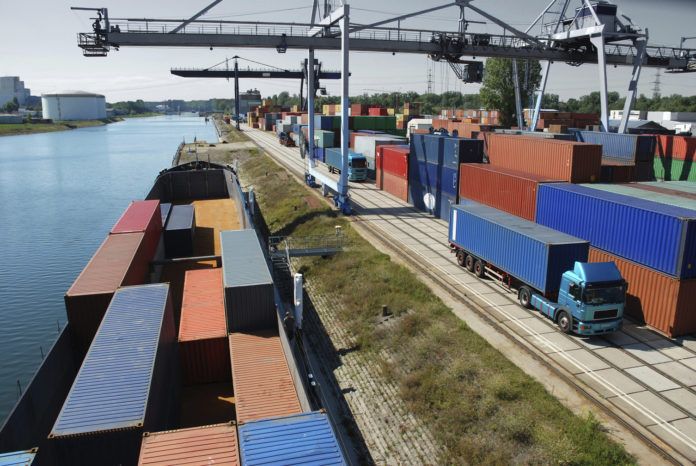As the chemical industry continues to boom in Louisiana and the Gulf South region, SEACOR AMH has created a new container-on-barge shuttle service from Baton Rouge to export those products via the Port of New Orleans.
The company planned to bring the container-on-barge shuttle service to the Lower Mississippi River Waterway this spring. The initial service will operate with one tug boat and up to six barges at once, the maximum number that can be moved at once through the Port Allen lock near Baton Rouge. SEACOR AMH already has facilities in the New Orleans area and has opened a terminal along the Port Allen Canal. Plans include the installation of intermodal equipment such as chassis, trucking and container handling equipment at Port Allen to move empties and spreaders.
SEACOR AMH (doing business as SCF AMH) is well-positioned in marine transportation and brings its experience on the Tenn-Tom Waterway to Louisiana. It is part of SEACOR Holding Inc.’s Inland River Services group, which includes SCF Marine Inc. The group owns and operates modern river transportation equipment; owns covered and open hopper barges, tank barges, inland river towboats and smaller harbor boats; provides ancillary services along the U.S. Inland River Waterways; and operates marine equipment on the Parana-Paraguay and the Magdalena river systems in South America.
“When we learned of the increasing volume coming out of Baton Rouge from the chemical sector we decided a shuttle service would be complementary to our ongoing services on the Mississippi River,” says Richard Teubner, Vice President of SEACOR AMH. “We developed the terminal operations and contractual agreements with port operations in New Orleans and Baton Rouge to get the customers interested.”
The customer interest was indeed there, as chemical companies expect to double and even triple shipping volume. There are 88 refineries located within a 100-mile radius of New Orleans and, according to Louisiana Economic Development, more than $6.4 billion in improvements at refineries and petrochemical plants in Louisiana are planned over the next two years.
“The Port of New Orleans is poised to meet the growing needs of the shippers upriver, and we are thrilled to work with SEACOR AMH to offer this new service,” says Gary LaGrange, president and CEO of the Port of New Orleans. “Shippers have many options and any increased service we can offer will help their bottom line. In addition to our rail and trucking partners, the container-on-barge service will provide shippers with another option to efficiently move their cargo.”
Brian Wyly, director of global logistics for Ascend Materials, which manufactures chemicals, fibers and plastics, says his company is investigating the operation and economics of container-on-barge.
“We do foresee some potential benefits. We could possibly have barge operations closer to our plant, thereby reducing over-the-road miles, as well as payload gains from being able to load containers heavier and not having to secure heavy weight truck permits through multiple states.”
There are substantial benefits to shippers by choosing the new shuttle service, says Teubner.
“The primary benefit to shippers is increasing the efficiency of their logistics chain,” Teubner says. “We provide them an option that eliminates the congestion that can occur on both ends of the supply chain in the surface transportation system. Container-on-barge improves port throughput, reduces dwell time and helps the environment by reducing emissions. It also offers an additional overweight corridor for transportation.”
Teubner also points out the production schedules of the manufacturers. “The majority of these refineries have a 24-hour per day/7-day per week operation and they can load and receive containers all day long. But they can’t deliver a container or pick up an empty 24/7 directly to the ports. Our facility in Baton Rouge will be able to better accommodate their production schedules,” says Teubner.
The United States Maritime Administration (MARAD) has been supportive of the new shuttle service. A “project designation” was applied for, which was jointly sponsored by the Port of New Orleans and the Port of Greater Baton Rouge on behalf of SEACOR AMH.
In April, U.S. Transportation Secretary Anthony Foxx designated the new service as an official Marine Highway Project. A Marine Highway Project is a planned service, or expansion of an existing service, on a designated Marine Highway Route, that provides new modal choices to shippers of cargo, reduces transportation costs and provides public benefits including reduced air emissions, reduced road maintenance costs and improved safety and resiliency.
In this case the designated Marine Highway Route is the Mississippi River, previously designated as the M-55, which will serve as the primary route for the Baton Rouge-New Orleans Shuttle project. The proposed container-on-barge service operating between the ports of Greater Baton Rouge and New Orleans will reduce congestion and bridge traffic on Interstate 10, the project designation announcement noted.
The designation means the project is part of MARAD’s America’s Marine Highway System. The Port of New Orleans is connected to 14,500 of the 29,000 nautical miles that make up America’s Marine Highway.
As the implementation of the shuttle service is being prepared, new opportunities have already been identified. Early growth potential is anticipated for possible service additions east/west, and in longer north/south long-haul routes of empty and full containers.
The Port of New Orleans is ready for surges in petrochemical-related cargo, according to Robert Landry, chief commercial officer for the port.
The port has invested over $100 million in capital improvement projects since 2012, and has a master plan to expand the Napoleon Avenue Container Terminal to 1.5 million TEU capacity by 2020. Expansion of the Mississippi River Intermodal Terminal and Yard to increase efficiency and volume throughput is expected to be completed this spring.
Landry added the port is also aggressively working to secure more ocean carriers and services to meet the increases expected from the chemicals boom.
A version of this article was originally published in Port Record, Winter 2016. Reprinted with permission.
Published in the second quarter 2016 edition of 10/12 Industry Report. Read more from this issue at 1012industryreport.com.










